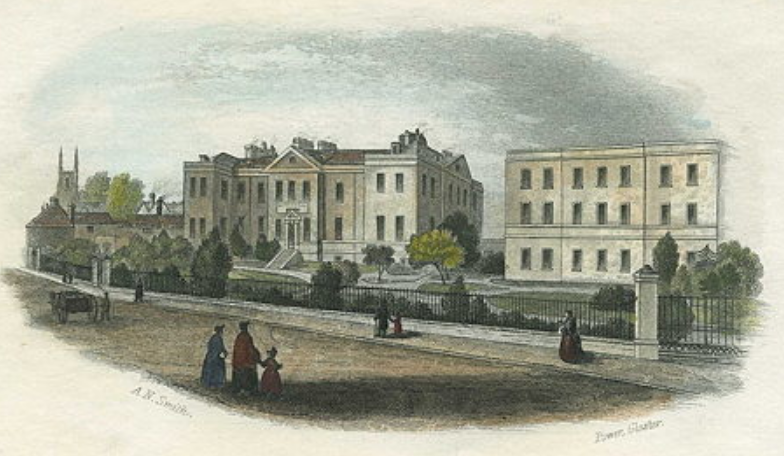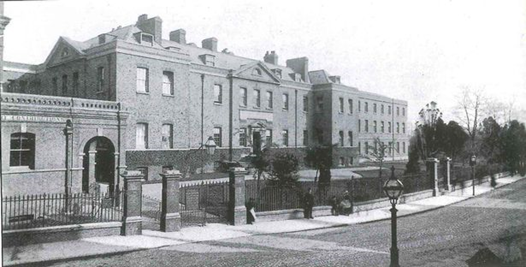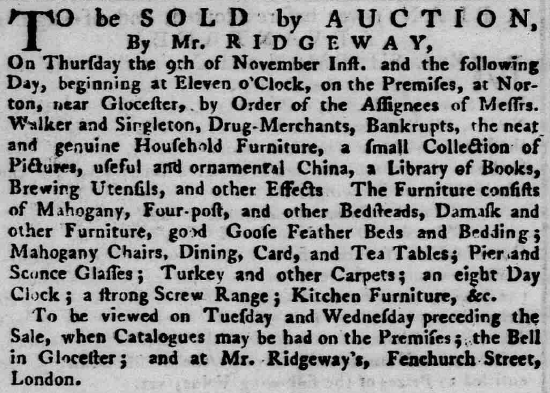The Singleton family of Norton Court
The Singleton family had held a number of official positions in Gloucester through the 1600s. A William Singleton, who was likely the son of Thomas Singleton, merchant of London and Gloucester, and possibly a woollen draper, was Sheriff of Gloucester in 1618 and Mayor of Gloucester in 1637. William was also Member of Parliament for Gloucester in 1640, in the Short Parliament, and fought briefly on the side of the Parliamentarians in the English Civil War, being a captain in the regiment of Colonel Henry Stephens in the defence of Gloucester in 1643. William was Mayor of Gloucester again in 1651. William married Martha Lane, daughter of William Lane of Gloucester at St Nicholas Church on 21 June 1624.
Laurence Singleton may have been the brother of William Singleton and hence also the son of Thomas. Laurence was Sheriff of Gloucester in 1634, Mayor in 1645 and may also have been an Alderman. In 1659 Laurence was elected as the Member of Parliament for Gloucester in the Third Protectorate Parliament and was appointed a militia commissioner for Gloucester on 9 August 1659. Laurence married Joan Robinson, daughter of Alderman Anthony Robinson.
Luke who purchased Norton Court was the grandson of the above Laurence Singleton and records would suggest that after marriage the family lived in Down Hatherley and then Norton. Luke married Martha Hind on 4 October 1716 at Saint Martin in the Fields, Westminster, London, and had at least six children; Mary, Sarah, Laurence, Luke, William and Thomas. Mary, Sarah, Laurence and Luke were baptised at Down Hatherley, whilst the family were living there, between December 1718 and December 1721. The latter two, William and Thomas, were both baptised at St Mary’s, Norton, on 24 March 1722 and 7 February 1726, respectively, suggesting that they had come to Norton in late 1721 or early 1722. Wife Martha was buried at Norton on 25 June 1738 and had a flat stone memorial in the churchyard at Norton that is no longer identifiable; "Here lyeth the body of Martha, the wife of Luke Singleton, Gent., who died 21 June, 1738. Also the bodies of Luke, Laurence and Sarah, their children".
On 18 July 1739, William ‘of Norton’ may have returned to London becoming an apprentice to his brother Laurence, a citizen and salter of the City of London, for the term of 7 years.
In possibly 1744, the family estates, which included a substantial house at Norton Court, passed from father to sons, Luke and William. Eldest son Laurence was described as being a ‘druggist of London, eldest son and heir’ of Luke in a Lease dated 14 August 1744 for a messuage, malthouse and garden in the parish of St Nicholas, Westgate Street, Gloucester, so it seems strange that he didn’t inherit Norton. Perhaps the estates were split amongst all of Luke Snr’s sons.
Luke Snr remarried a widow, Mary Bell, at Norton on 5 August 1744, both recorded as being ‘of this parish’.
In 1720 there was a hospital in Gloucester that belonged to Luke Singleton Snr and whilst at Norton he designed a new Gloucester infirmary, later Gloucester Royal Hospital, Southgate Street, which was built in 1755 and was financed by gifts and legacies, the timbers from the Forest of Dean being donated by King George II.

The Infirmary, 1848

The Royal Hospital closed in 1975 and was demolished in 1984.
Luke died and was buried at Norton on 30 August 1768. In his Will of 1765 Luke makes bequests to each of his sisters and to sons Thomas and William.
A Thomas Singelton was buried at Norton in 1773.
A Luke Singleton, possibly the son, or another person altogether, was still in possession of property at Bishopgate in 1787.
The Norton Court estates passed to son William Singleton.
William Singleton was a "druggist" or chemist in London and married Ann Bird of Barton-on-the-Heath, daughter of John Bird MP. If he was living in London, William still kept close ties to Norton and Gloucester. He is described as ‘of Norton’ in several leases from the 1760s and was appointed sheriff of Gloucestershire in 1769. William was declared bankrupt and was also somehow involved with the bankruptcy of Samuel Garbett the Birmingham chemist. William died and was buried at Norton on 6 January 1778 and his wife became named in the bankruptcy due to her being sole executor. Widow Ann was still being assessed for land tax on property at Norton in 1769.
Widowed Mary was buried on 9 May 1780, also at Norton, the last reference to the family in the parish records.
The following advertisement selling the contents of Norton Court was published in the Gloucester Journal newspaper of 6 November 1780. Singleton appears to have been in a business partnership with a Mr Walker as drug merchants but the business had gone bankrupt.

In a Chancery case of Singleton against Mitchell and others from 27 June 1786 we find a particular of the estate late of William Singleton, deceased. The estate was to be sold in three lots with Lot 1 being the mansion house of Norton Court.
In the 1851 Census there is a George Singleton who states that he was born at Norton, Glos, in approximately 1802. He was then a vintner, visiting in the household of John Gateley at 44 Greens Village, St Jude’s, Birmingham. I can find no other references to this George either before or after this date so am not sure if there are any connections. There is a Singleton Farm in neighbouring Sandhurst and property at Down Hatherley that also have Singleton family connections.
